by Olivia Ladanyi // 30 May, 2023
In ‘Human Is’ at Schinkel Pavillon, 19 artists explore possible posthuman futures and question the human condition today. Combining historical artworks with those produced specifically, the exhibition de-centers the human protagonist and uses science fiction to play with our fears and anxieties around technological advancement and supernatural otherness. On the way to the show, I’d had a conversation with my friend about AI chatbot ChatGPT and its threat to jobs, including my own. The fear only got louder on entering the windowless ground floor space, packed with glowing artworks that felt alive and almost breathing.
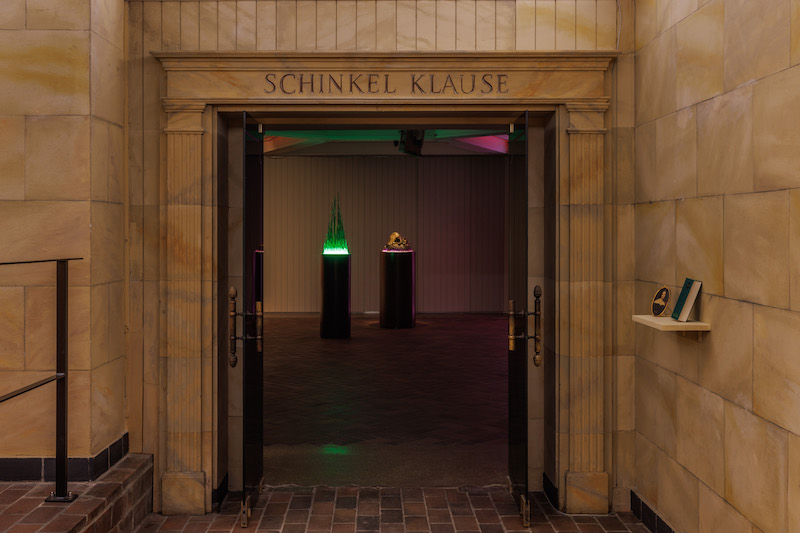
‘Human Is,’ 2023, exhibition view at Schinkel Pavillon, Berlin // Courtesy of Mike Kelly and Galerie Hussenot, Paris, photo by Frank Sperling
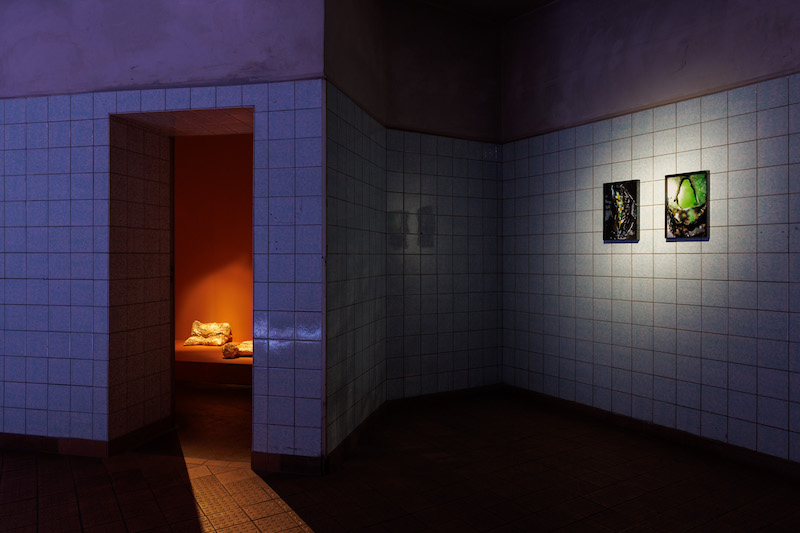
‘Human Is,’ 2023, exhibition view at Schinkel Pavillon, Berlin // Courtesy of Diane Severin Nguyen, Nour Mobarak, Galerie Molitor and Dorothy Zhang, photo by Frank Sperling
Borrowing its name from the short story by Philip K. Dick, ‘Human Is’ interrogates the boundaries between humanity and the technological, extraterrestrial, artificial and biological other. It leaves you with a residual sense that perhaps these boundaries don’t exist at all. For centuries, science fiction has held up a mirror to the changing human condition and its values, fears and limitations. Yet in these rooms, as Laura McLean-Ferris writes in her accompanying essay, “the mirror folds and cracks, revealing the outside to be inside. It is as though humans might cut themselves open and find wires, data, tendrils of vine, insects and circuit boards, drugs, images, sunlight.” This is the overall sense that you get when anxiously feeling your way through the exhibition. Confronted with a version of humanity that has been folded inside out, we are projected headfirst into a posthuman future where our kind is rendered unrecognisable and obsolete, revealing us to be the very other that we fear.
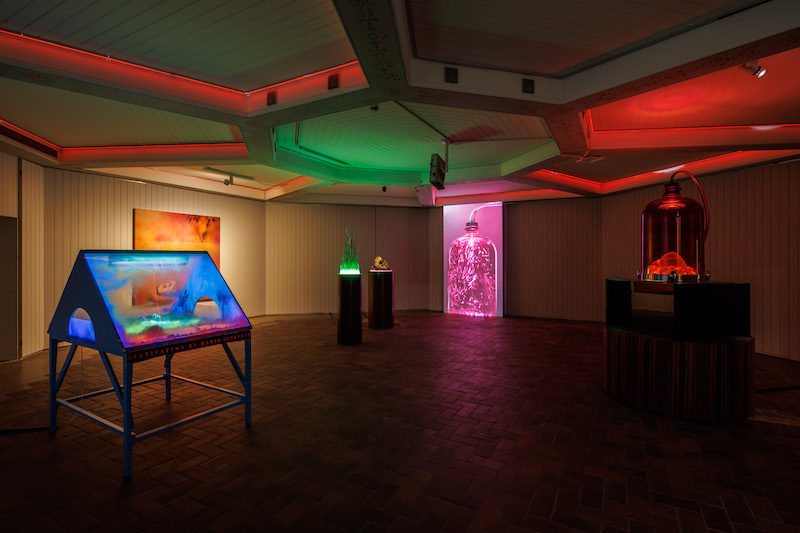
‘Human Is,’ 2023, exhibition view at Schinkel Pavillon, Berlin // Courtesy the artists and Schinkel Pavillon
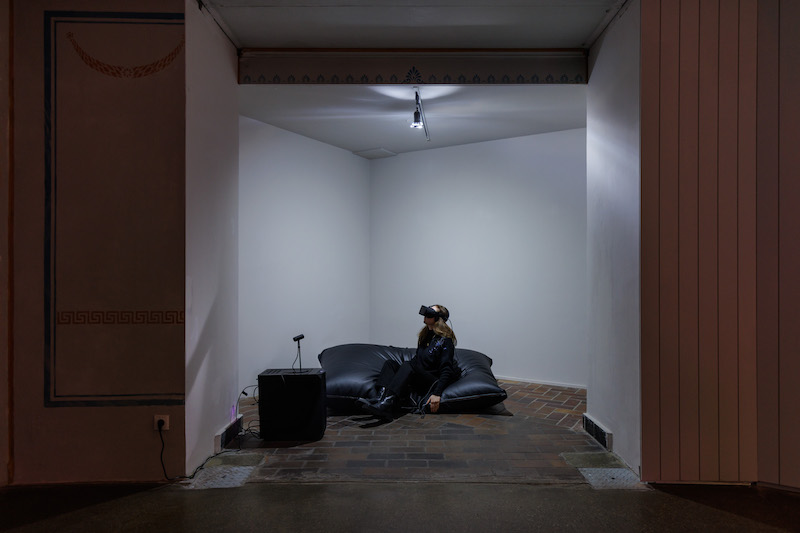
Sidsel Meineche Hansen: ‘Second Sex War Zone,’ 2016, VR headset playing CGI animation and vegan leather beanbag // Courtesy the artist and Rodeo, London, photo by Frank Sperling
The first room, housing works by Mike Kelley, Ovartaci, Sidsel Meineche Hansen, Tishan Hsuoffers and Tetsumi Kudo, produced between the early 20th century and 2016, sets the scene for the exhibition with a visual attack of fluorescent alien creatures; otherworldly illuminated city and landscapes; and sinister shapes lurking inside a monumental glowing container, which is also projected animatedly onto the wall. Packed together in the small dark space, these jarring works introduce us to the idea of the extraterrestrial in its simplest form—the one familiar to us from science fiction books and movies of the past two centuries. On the wall hangs an eerie gouache painting of an animal-like alien creature with slender, elongated facial features and greenish skin. On the floor is a vegan leather beanbag accompanied by a VR headset, on which ‘DICKGIRL 3D(X)’ is playing. The pornographic CGI animation shows augmented, hyper-sexualised EVA v3.0 appropriating “genital props” to emulate sex scenes, exploring posthuman porn and the commodification of 3D bodies. As the voyeur, we witness the protagonist liberate herself from the viewer’s gaze as well as gender binary power structures.
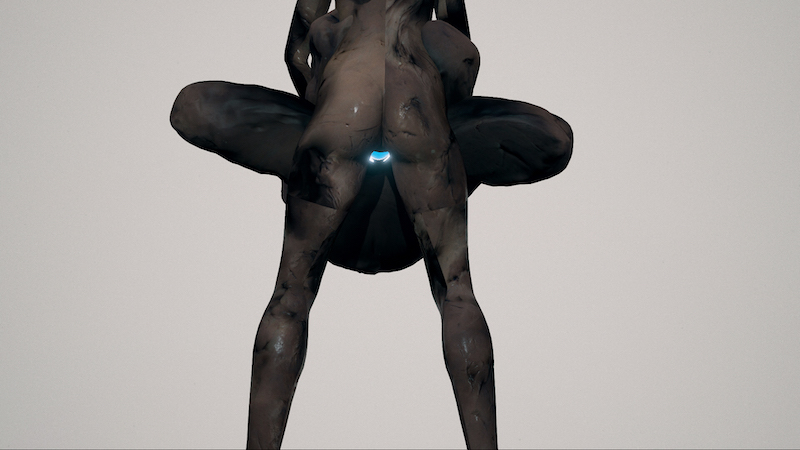
Sidsel Meineche Hansen: ‘DICKGIRL 3D(X),’ 2016, CGI animation // Courtesy of Werkflow London
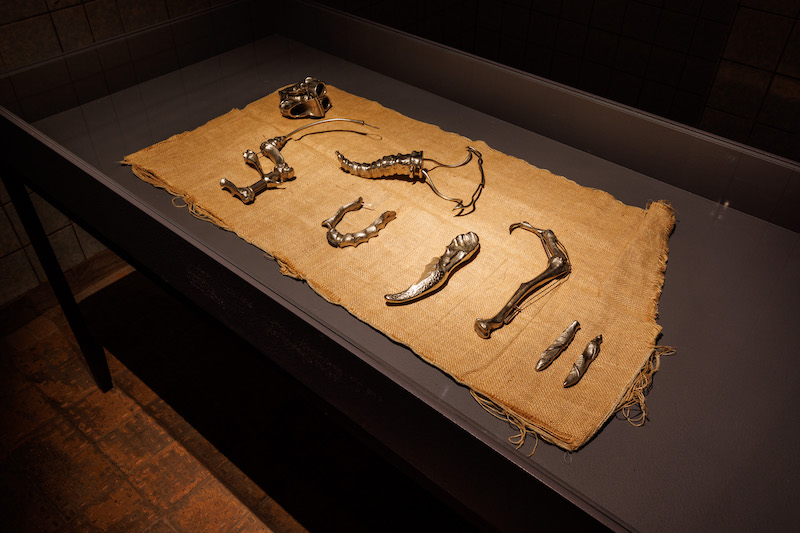
David Cronenberg: ‘Instruments for operating on mutant women,’ 1988, nickel-plated brass // Courtesy the artist and TIFF, Toronto, photo by Frank Sperling
The feeling of unease continues in the claustrophobic rooms leading off from the main octagonal space. A traditional West African wooden figure stares out at us from inside an industrial resin case, as if asking, what have you done to me? What have we become? Matthew Angelo Harrison’s ‘Touched By An Angel’ removes the chasm between humanity’s anthropological past and our uncertain future as though the time and space in between never existed at all. We are then presented with science fiction filmmaker David Cronenberg’s metal instruments for operating on mutant women, whose bodies, even in their absence, become fetishised. Modelled on female sex organs, the sculptural objects’ forms imply the fantasies inscribed in them. To the female viewer, these beautiful instruments become threatening, foreboding a patriarchal dystopia whereby the line between technology and science crosses into abusive territory.
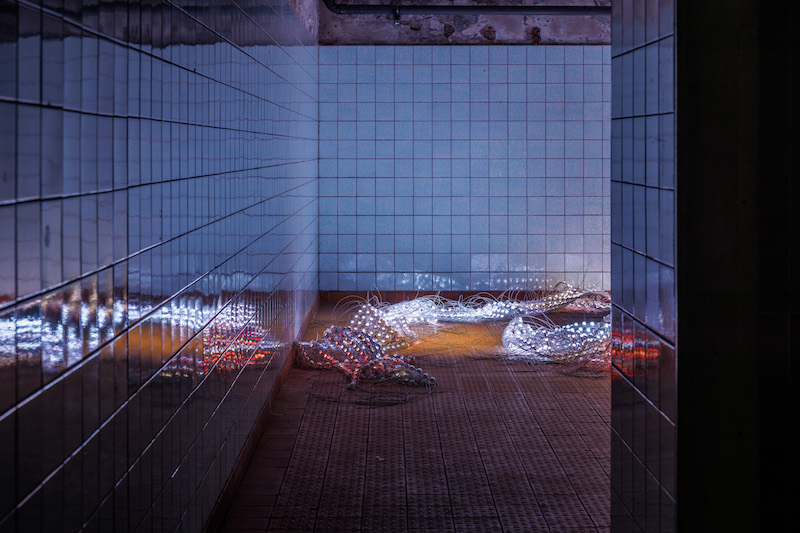
WangShui: ‘Fundamental Attribution Error,’ 2023, AI-driven LED mesh // Courtesy the artist and High Art, Paris, photo by Frank Sperling
Journeying through the remaining rooms on the ground floor, the exploration of the “other” becomes increasingly complex and more of a real threat to humanity as we know it. WangShui’s tangled web of AI-driven LED lights, produced specifically for ‘Human Is,’ examines the expanding boundaries of the body. The twinkling wire mesh twists and turns its way across the floor; existing, working, thinking in a futuristic world where humanity has evolved to become a body-less neural system. The “creature” is at once beautiful, inviting, fascinating and absolutely petrifying. Recording a moment in time when humans are divided into different parts and reassembled, ‘Fundamental Attribution Error’ makes these new modes of consciousness seem like a real possibility.
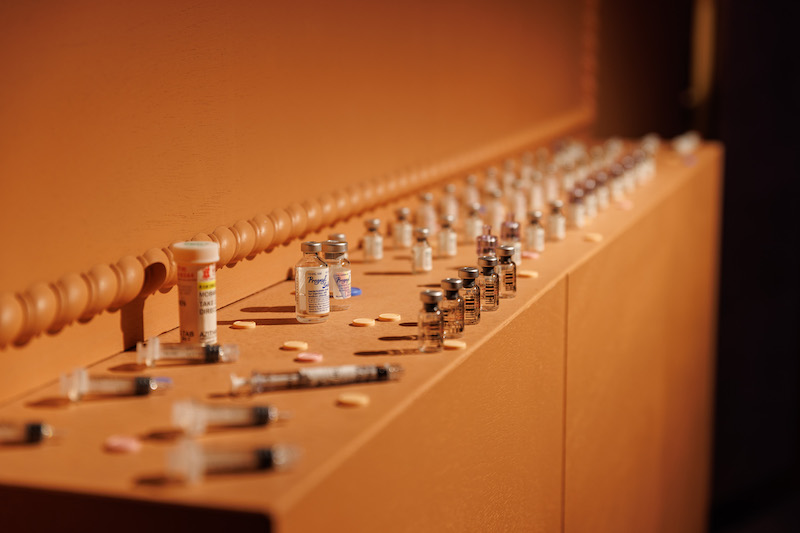
Nour Mobarak: ‘Reproductive Logistics 2,’ 2021, glass vials, injection pins, syringe, plastic // Courtesy the artist and Miguel Abreu Gallery, photo by Frank Sperling
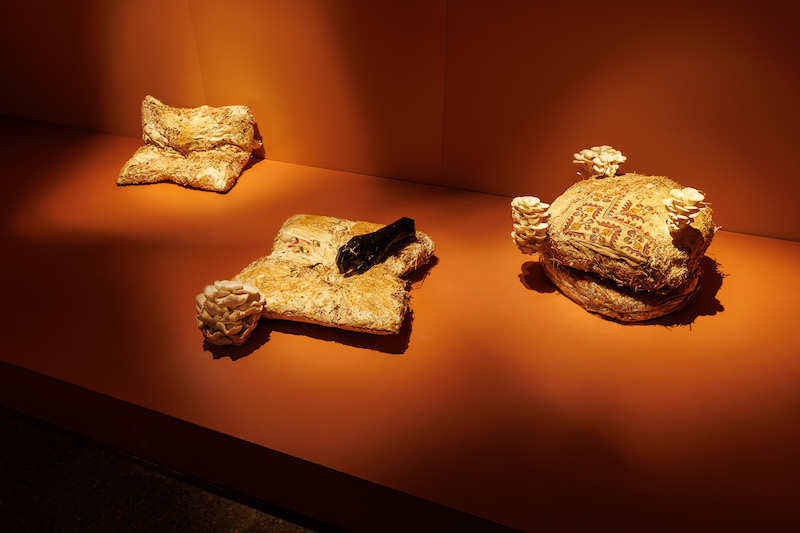
Nour Mobarak: ‘Reproductive Logistics 3.1 – 3.7,’ 2023, textile, straw, apple wood, Pleurotus citrinopileatus mycelium, Trametes versicolor mycelium, oil paint, plastic, latex paint // Courtesy the artist, photo by Frank Sperling
Empty pharmaceutical vials and syringes line the walls of the next room in part II of Nour Mobarak’s ‘Reproductive Logistics’ series, which explores the social, material and technological advancements around reproduction. This work is the remains of her ‘Logistique Elastique’ exhibition, where she underwent the process of egg freezing and visited the gallery to deliver the packaging of her daily dose of medication. Alongside newly produced ‘Reproductive Logistics III,’ where objects related to conception and nurture are made from straw and mycelium fungus, Mobarak presents the decay of human fertility and its potential loss entirely, invoking the end of humankind altogether. In the remainder of the exhibition, this abandoned space is taken over by the supernatural other and we are presented with what possible manifestations of posthuman life might look like.
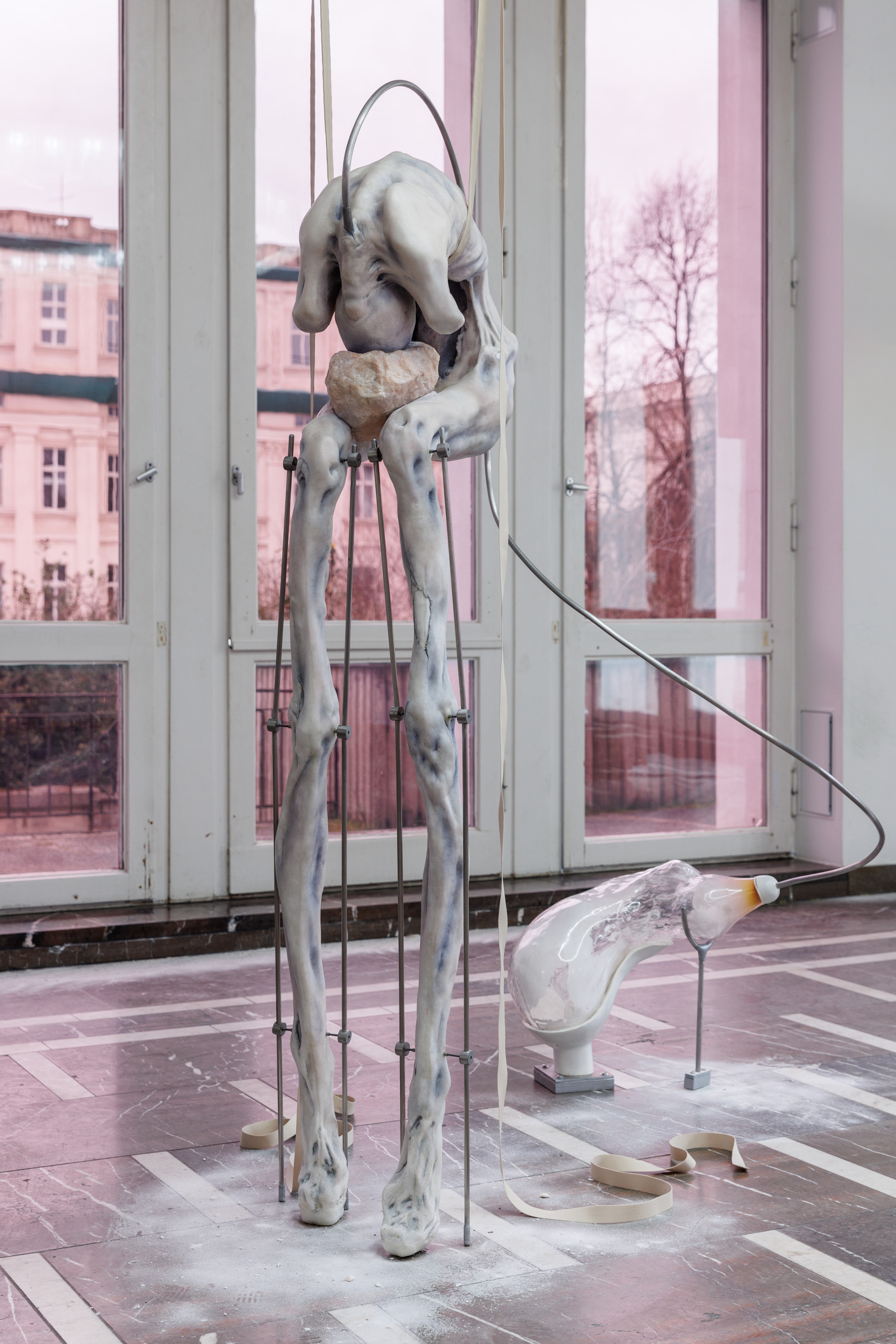
Ivana Bašić: ‘Belay My Light, the Ground Is Gone,’ 2018, wax, pink alabaster, blown glass, breath, dust, weight, oil paint, pressure, stainless steel // Courtesy the artist, photo by Frank Sperling
Perhaps it is our reintroduction to natural light, but upstairs, in the gallery’s iconic rotunda space, we are faced with a more optimistic view of a posthuman future, forcing us to consider the potential benefits of the absence of the human body. Curving in on itself, and at once fleshy and bony, Ivana Bašić’s wax sculpture captures a moment of metamorphosis, where the body is in the process of losing its physical form, abandoning its material limitations. Similarly, Joachim Bandau’s 1970s humanoid sculptures, equipped with bodily tubes and holes, form fleshy apparatuses resembling “organic-technoid hermaphrodites.” Machine-like and human, minimalist and monstrous, these works symbolise the fusion of the human body with technological commodities, industrial automation and medical innovations. Through an “aesthetics of violence”, Bandau brings the darker side of human nature and its entangled desires to the forefront. These fibreglass amorphous forms present a world in which humanity can perhaps exist and function without creating damage or harm.
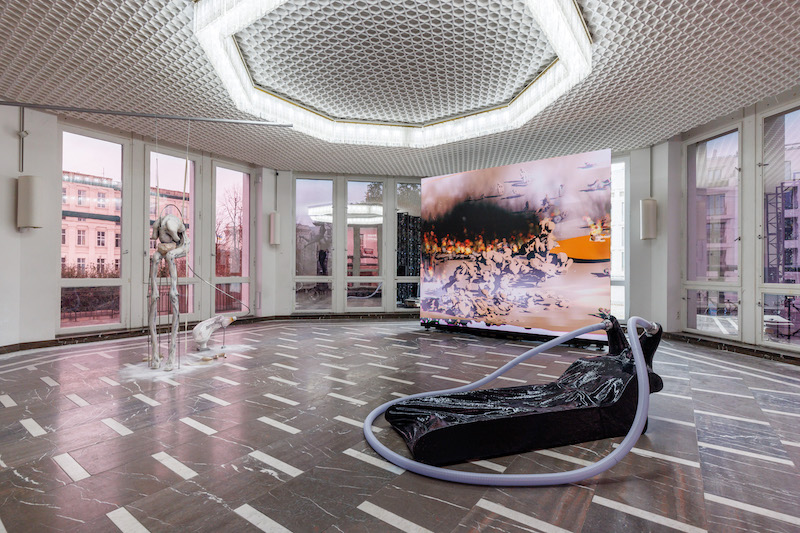
‘Human Is,’ 2023, exhibition view at Schinkel Pavillon, Berlin // Courtesy the artists, photo by Frank Sperling
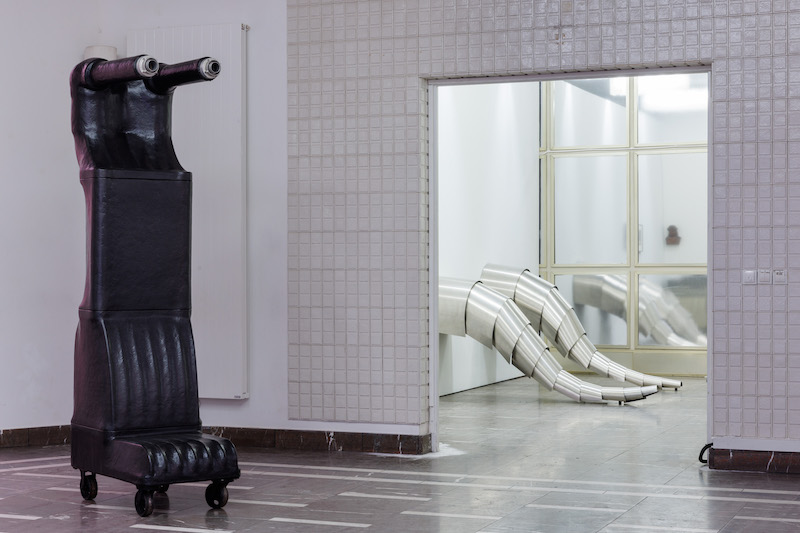
‘Human Is,’ 2023, exhibition view at Schinkel Pavillon, Berlin // Courtesy Joachim Bandau, Sandra Mujinga, Neues Museum Nuremberg, Croy Nielsen, Vienna and Sammlung Haus N, Athens, photo by Frank Sperling
Inspired by Afrofuturist author Octavia Butler’s idea of humans mating with aliens, Sandra Mujinga’s site-specific tentacle-like ‘Love Language’ works also explore the aesthetics of a new hybrid life form. Jutting out and trailing down from the gallery wall, the aluminium-steel sculptures appear as though they could be part of a larger creature, of which we are unable to catch full sight. This unknowable, unseeable giant manifests what is to become of our species, which we cannot truly perceive until it is directly in front of us and too late to turn from. We can only catch glimpses of what it might look like. ‘Human Is’—through a clever collaborative narrative that straddles two centuries—offers us a porthole that makes us want to throw on the breaks to humanity’s unpredictable evolution, securing it in all its flawed, fleshy humanness.
Exhibition Info
Schinkel Pavillon
Group Show: ‘Human Is’
Exhibition: Mar. 19 – Jul. 23, 2023
schinkelpavillon.de
Oberwallstraße 32, 10117 Berlin, click here for map



























